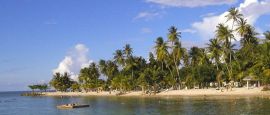Getting around Trinidad and Tobago
Caribbean Airlines (www.caribbean-airlines.com) runs regular flights between Piarco (Port of Spain) and Crown Point (Tobago). During peak seasons (especially Carnival time), these are often heavily booked.
The road network in Trinidad between major towns is good, but traffic around Port of Spain can be difficult during rush hour and around Independence Square at any time. Two major highways run north-south and east-west. Roads which run off major routes can be very unpredictable, and are susceptible to poor weather conditions.
In Tobago, the roads, though narrow in parts, are improving dramatically and most of the island is easy to reach. There is a major highway (Claude Noel Highway) running west-east. Tourists should have no qualms about driving around Tobago at any time of the day or night, although caution should be exercised in more rural areas where chickens and sheep may wander across roads. Hand signals, which may be unfamiliar, are often used.
Cars and motorcycles are available in Port of Spain or Scarborough, and can be arranged via hotels and in Tobago at the airport as well. Consider jeep hire for exploring Trinidad’s wild interior, much of which is accessible only by dirt tracks. You need to be at least 25 years of age and have held a licence for a minimum of two years to hire a vehicle. Mopeds and trailbikes (increasingly popular) can be hired too.
All official taxis have registration 'H'. Hiring a private taxi (which must be done via telephone) is much more expensive but gives the freedom to go where you like. Though there are fixed rates for certain journeys (at official taxi stands such as Piarco International Airport, rates for main journeys are displayed on the taxi stands), it's best to establish this before you start your journey.
The quickest and most cost-effective way to get around is by Route taxis and Maxi taxis which serve standard routes within Trinidad, particularly around Port of Spain, starting their route from, in or near Independence Square. These have fixed rates. In Tobago, Route taxis (H registered and unregistered) are plentiful along most major routes during the day and can be stopped anywhere along them. Drivers will indicate they have room by sounding their horn.
The abundance of taxis and the dearth of bus routes in many parts of Trinidad and Tobago mean shared cabs are the accepted public transport option nationwide.
Cycling, particularly mountain biking, is taking off in Trinidad & Tobago. Tobago leads the way here, with several places in the Lowlands west of Scarborough hiring out bicycles.
The nation’s bus connections have seen a boost in recent years, with many new vehicles introduced into a previously ailing fleet. The terminal in Port of Spain is at City Gate on South Quay, from where buses operate to San Fernando and other destinations in Trinidad. Some places in Tobago are served from the main bus station on Sangster’s Hill in Scarborough.
Trinidad's speed limit is 80kph (50mph) on highways and 50kph (31mph) in built-up areas. While in Tobago, do not exceed 50kph (31mph). There is no left turn on a red light and u-turns are illegal. Drivers and front-seat passengers are legally required to wear a seat belt.
An International Driving Permit of a national licence from the Bahamas, Canada, France, Germany, the UK or the USA. These are valid for 90 days after arrival.
Taxis noticeably outnumber buses even in Port of Spain and as such, most public transport journeys in the city are now made by shared taxis.
There are two options for the crossing between Trinidad (Port of Spain) and Tobago (Scarborough), both run by the Port Authority of Trinidad and Tobago (www.patnt.com). The slow car ferry/passenger service takes approximately 6 hours and the fast catamaran crossing is 2 hours 30 minutes (two to three daily).
A regular water taxi service run by NIDCO (www.nidco.co.tt) also links Port of Spain with San Fernando, Trinidad’s other major city. If you are arriving by private boat, a clearance certificate from the last port of call and the vessel’s registration certificate are essential requirements.
Do you have any Feedback about this page?
© 2025 Columbus Travel Media Ltd. All rights reserved. No part of this site may be reproduced without our written permission, click here for information on Columbus Content Solutions.




 You know where
You know where